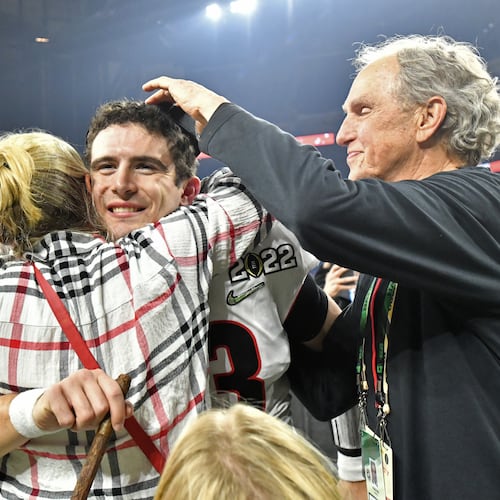There have been some major developments in baseball’s ongoing labor pains that have potentially dire implications for the world champion Braves.
For one, it appears that as well as suffering a season-ending knee injury in July, the Braves’ young star outfielder Ronald Acuna has been replaced by a gray, formless silhouette.
Google Braves/roster/mlb.com. Gone from the official website is the usual photo headshot included for each member of the 40-man roster, replaced by an indistinct, colorless outline of a head. The entire Braves roster now looks as alike as the freshman class in a prep-school yearbook.
Acuna, the future face of the franchise, no longer has a face.
Working off information provided, I can tell you this shadow Acuna stands 6-foot tall and weighs 205 pounds. But I can’t tell you the color of his eyes or the tilt of his smile.
What’s further unsettling is that first baseman Freddie Freeman is no longer even listed as a member of the Braves, seeing how he went unsigned before the lockout and now resides in a parallel dimension between darkness and light until this great game is set free again from all the grasping, silly people involved.
No one can say how long the lockout – imposed by ownership after its collective bargaining agreement with the players expired Dec. 1 – will last. But given the tenor of the disagreement to date, we shouldn’t expect resolution tomorrow.
The sides have held no new talks this month, baseball’s hot stove going as cold as a North Dakota lamppost. There is time to fix this yet. No panic. But erasing the players from every teams’ website and social-media account is hardly a positive step toward détente.
Shortly before the lockout, the game was abuzz with news of free agents on the move – the Mets going wild signing starter Max Scherzer (3 years, $140 million), outfielders Starling Marte (4 years, $78 million) and Mark Canha (2 years, $26 million) and infielder Eduardo Escobar (2 years, $20 million); Corey Seager to Texas (10 years, $325 million); infielder Javier Baez to Detroit (6 years, $140 million); Cy Young winner Robbie Ray to Seattle (5 years, $115 million); starter Kevin Gausman to Ray’s former team, Toronto (5 years, $110 million); Chris Taylor re-signing with the Dodgers (4 years, $60 million).
Those are just some of the splashier moves. The Braves, who seldom splash, also picked up a reliever – Kirby Yates (2 years, $7 million) – and a backup catcher, Manny Pina (2 years, $8 million).
Then, instantly, as with the turn of a spigot, it all went away. Baseball not only shut down, but also disavowed its players on all platforms. There hasn’t been a mention of a current player on the Braves’ Twitter site this month, but plenty of photos of the mascot, Blooper. Stories on the team website now center on former players or coaching staff members.
Players are rather important to generating any interest – in season or out – for the grand old game. You’ll know we’re really in trouble when they get down to posting highlights from the Liberty Media board-member softball game.
Oh, and Freeman – remember what he looks like? Still not signed.
We should be reveling in his re-signing about now, shouldn’t we?
The Athletic looked at this league-wide player purge and received a two-word answer from Commissioner Rob Manfred when asked if it was for legal reasons: “It is.” But when it followed up with various legal experts seeking possible concrete reasons for the tactic, it found little.
But then, of course, had MLB continued to use the players’ image and likeness, there likely would be complaints from that side. Self-destructive behavior can go both ways.
The nuances of this lockout are varied and complex, so try to stay with me here: Ownership wants to keep more of the treasure for itself. The players would prefer to funnel it to their direct deposit – and earlier in their careers. Now just add some key phrases like service time, arbitration, luxury tax, blah, blah, blah.
It has been pretty well established that between making the mortgage, dealing with the latest variant and trying to keep their kids from turning into complete phone-screen zombies, fans don’t have time in their busy days to worry about baseball’s negotiating stances. Just play, and once every 26 years or so produce a world championship, and they’ll stay interested.
Trying to take the players out of the game is as goofy as removing the fish from the aquarium. All that’s left in both cases is the mess at the bottom of it all.
I think we all can agree that if players no longer officially exist, that is going to make it really difficult for the Braves and Red Sox to stage any kind of compelling spring-training opener in North Port on Feb. 26. Baseball already tried out cardboard cutouts in the seats during the pandemic and found that wanting. Faceless cutouts on the field will be even less satisfying.
There’s time yet to get back to the business of filling rosters and staging dress rehearsals in Florida and Arizona. But, alas, the act of replacing worthwhile goals with dumb stuff has begun. Once started, that’s a habit hard to break.
About the Author
The Latest
Featured



